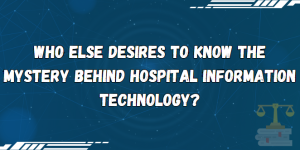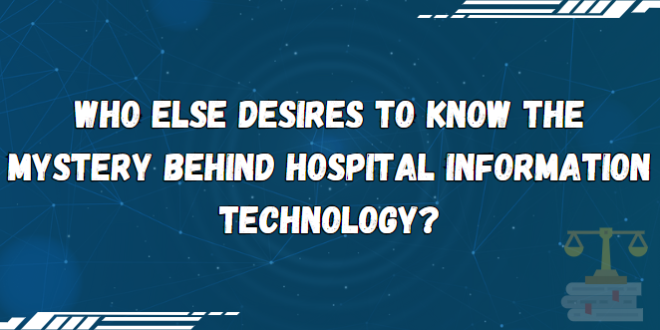Hospital information technology (HIT) has revolutionized the healthcare industry, streamlining operations, improving patient care, and enhancing overall efficiency. In this article, we will delve into the world of hospital information technology and unravel the mysteries surrounding its impact on healthcare delivery. Discover how HIT is transforming hospitals and shaping the future of healthcare.
1. The Evolution of Hospital Information Technology

Hospital information technology has come a long way from paper-based records and manual processes. With the advent of electronic health records (EHRs), computerized physician order entry (CPOE) systems, and advanced healthcare analytics, hospitals have witnessed a significant transformation in how data is captured, stored, and utilized.
2. Enhancing Patient Care and Safety
Hospital information technology plays a vital role in improving patient care and safety. Through electronic health records, healthcare providers have access to comprehensive patient information, allowing for more accurate diagnoses, timely interventions, and improved medication management.
3. Streamlining Administrative Tasks
Administrative tasks can be time-consuming and prone to errors. HIT solutions automate various administrative processes such as appointment scheduling, billing, and insurance claims processing, reducing paperwork, minimizing errors, and freeing up valuable time for healthcare professionals.
4. Data Security and Privacy
As hospitals transition to digital systems, data security and privacy become paramount. Hospital information technology incorporates robust security measures to protect sensitive patient information from unauthorized access, ensuring compliance with healthcare regulations and standards.
5. Integration of Systems and Interoperability
Interoperability is a key aspect of hospital information technology. The ability of different systems and applications to seamlessly exchange data and communicate with each other enhances care coordination, reduces duplication of tests, and facilitates the exchange of vital information between healthcare providers.
6. The Challenge of Implementation
Implementing hospital information technology solutions can be complex and challenging. It requires careful planning, stakeholder engagement, and training to ensure a smooth transition. Healthcare organizations must navigate through potential barriers and address resistance to change.
7. Increasing Access to Medical Records
Hospital information technology empowers patients to access their medical records and health information conveniently. Online portals and mobile applications allow patients to view test results, request prescription refills, and communicate with healthcare providers, promoting patient engagement and self-management.
8. Enhancing Clinical Decision-Making
Hospital information technology provides healthcare professionals with tools and systems that assist in clinical decision-making. Decision support systems, clinical guidelines, and data analytics enable evidence-based practices and improve patient outcomes.
9. Telehealth and Remote Monitoring
Advancements in hospital information technology have paved the way for telehealth and remote monitoring capabilities. Patients can receive virtual consultations, monitor their health conditions remotely, and reduce the need for in-person visits, especially in rural or underserved areas.
10. Improving Communication and Collaboration
HIT solutions foster communication and collaboration among healthcare teams. Secure messaging platforms, shared calendars, and electronic referrals enable seamless communication, enhancing care coordination and reducing the risk of communication errors.
11. The Importance of Data Analytics
Data analytics plays a crucial role in hospital information technology. By analyzing large volumes of healthcare data, hospitals can identify trends, predict outcomes, and optimize resource allocation, leading to more efficient operations and improved patient outcomes.
12. The Future of Hospital Information Technology
The future of hospital information technology holds immense potential. Advancements in artificial intelligence, machine learning, and interoperability will further enhance the capabilities of HIT, enabling personalized medicine, precision diagnostics, and proactive healthcare management.
13. Conclusion
Unveiling the Power of Hospital Information Technology
Hospital information technology is transforming healthcare delivery, revolutionizing patient care, and driving efficiency in hospitals. From streamlining administrative tasks to improving clinical decision-making, HIT is reshaping the healthcare landscape. Embracing the power of hospital information technology is key to delivering quality care in the digital age.
Stay Tuned for More Exciting Articles
Thank you for exploring the world of hospital information technology with us. We hope you found this article informative and insightful. Stay tuned for more captivating articles on various topics. Until then, goodbye, and see you in our next fascinating piece!
 Spacetimes A collection of the latest news and information from various trusted sources
Spacetimes A collection of the latest news and information from various trusted sources
